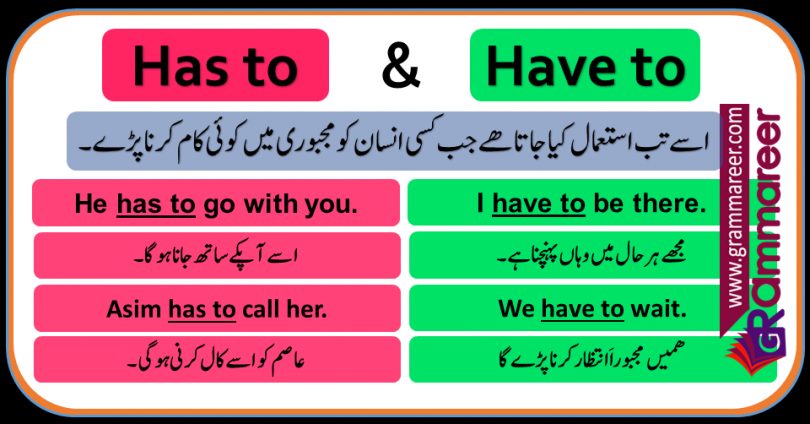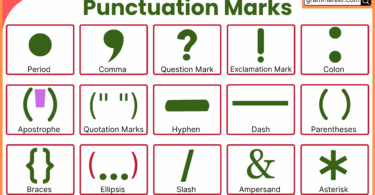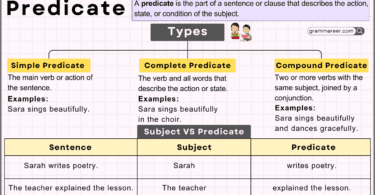In this blog post, we’ll cover the difference between “have to” and “has to” in English. These phrases express obligations, but “have to” is used for plural subjects, while “has to” is for singular subjects. Understanding this simple distinction can improve your sentence structure and fluency. For more grammar tips, visit our grammar section.
Table of Contents
Use of Have To and Has To
The use of “have to” is for plural subjects, while “has to” is used for singular subjects. Both phrases express necessity or obligation in English. We use “have to” and “has to” for present situations. For the past, we use “had to”, and for the future, we say “will have to” to show necessity or obligation.
Have to = کسی کام کو کرنا ضروری ہونا یا مجبوری ہونا
استعمال:
اسے اُس وقت استعمال کیا جاتا ہے جب کسی شخص کو مجبوری یا ضرورت کے تحت کوئی کام کرنا پڑے۔
Use of “Have to”
“Have to” is used when someone is compelled or forced to do something, or when there is an obligation. It expresses necessity or requirement. The phrase is commonly used in present and future tense.
- In Present Tense:
“Have to” is used with “I,” “You,” “We,” and “They.” - In Future Tense:
“Will have to” is used when discussing a future obligation or necessity.
Examples
- I have to leave
مجھے جانا ہے - We have to study for the exam
ہمیں امتحان کے لیے پڑھنا ہے - You have to complete this task
آپ کو یہ کام مکمل کرنا ہوگا - They have to submit the report tomorrow
انہیں کل رپورٹ جمع کرنی ہوگی - We have to wait for the bus
ہمیں بس کا انتظار کرنا پڑے گا
Use of “Has to”
“Has to” is used with the third person singular (he, she, it, or singular nouns). It is used to indicate that someone is required to do something.
Examples:
- He has to attend the meeting
اسے میٹنگ میں شرکت کرنی ہوگی - She has to finish her homework
اسے اپنا ہوم ورک مکمل کرنا ہوگا - It has to be done by tomorrow
اسے کل تک مکمل کرنا ہوگا - Asim has to call her
عاصم کو اسے کال کرنی ہوگی - My sister has to wake up early
میری بہن کو جلدی اٹھنا ہوگا
Use of “Had to”
“Had to” is the past tense form of “have to” and is used to express an obligation or necessity that was required in the past.
Examples
- I had to leave early yesterday
مجھے کل جلدی جانا پڑا - We had to cancel the meeting
ہمیں میٹنگ منسوخ کرنی پڑی - You had to submit the assignment on time
آپ کو اسائنمنٹ وقت پر جمع کرنی پڑی - She had to go to the hospital
اسے اسپتال جانا پڑا - They had to wait for an hour
انہیں ایک گھنٹہ انتظار کرنا پڑا
Use of “Will Have to”
“Will have to” is used to indicate that something will be required or obligated to be done in the future. It expresses a necessity in the future tense.
Examples
- You will have to come early
آپ کو جلد آنا پڑے گا - He will have to take the test next week
اسے اگلے ہفتے امتحان دینا پڑے گا - We will have to make a decision soon
ہمیں جلد فیصلہ کرنا پڑے گا - She will have to change her plans
اسے اپنے منصوبے تبدیل کرنے پڑیں گے - They will have to wait until the meeting ends
انہیں میٹنگ ختم ہونے تک انتظار کرنا پڑے گا
Conclusion
“Have to,” “has to,” “had to,” and “will have to” are crucial for expressing obligations in English. These phrases convey the necessity of actions in the present, past, or future. Mastering their use helps you communicate more confidently and naturally in everyday conversations and future plans.
You May Also Like





